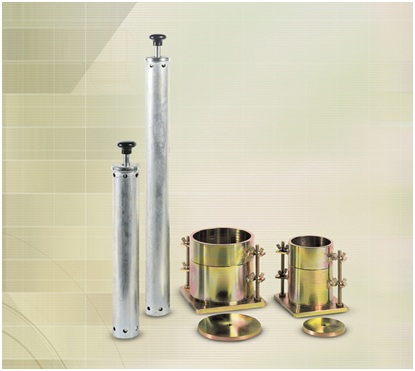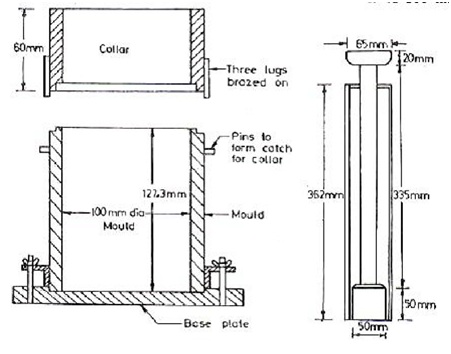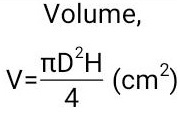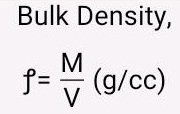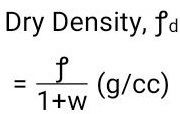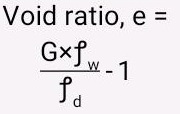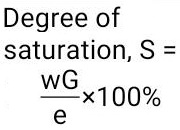The examination and compression testing of cores cut from hardened concrete is a well – established method, enabling visual inspection of the interior regions of a member to be coupled with strength estimation. Other properties which can be measured is also given in this paper.
IS: 456-2000 specified that the points from which cores are to be taken and the number of cores required shall be at the discretin of the engineer-in-charge and shall be representative of the whole of concrete concerned in no case, however, shall fewer than three cores be tested. Core shall be prepared and tested as described in IS: 516.
Concrete in the member represented by a core test shall be considered acceptable, if the average equivalent cube strength of the cores is equal to at least 85 percent of the cube strength of the grade of concrete specified for the corresponding age and no individual core has a strength less than 75 percent. In case the core test results do not satisfy these requirements, or where such tests have not been done, load test may be resorted to.
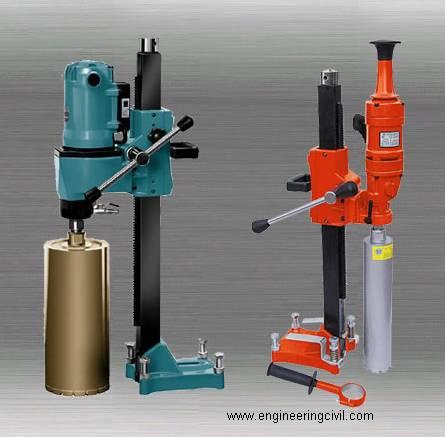
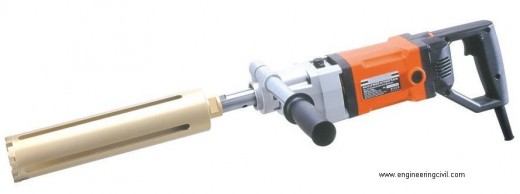
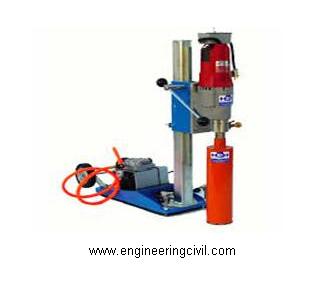
CORE CUTTING MACHINES
CORE DRILLING
A core to be tested for strength shall not be removed from structure until the concrete has become hard enough to permit its removal without disturbing the bond between the mortar and the coarse aggregate. Normally the concrete shall be 14 days old before the specimens are removed. It is preferred the concrete should be 28 days old for drilling cores.
Advertisements
A core is usually cut by means of a rotary cutting tool with diamond bits. The concrete core drilling machine is portable, but it is heavy and must be firmly supported and braced against the concrete to prevent relative movement which will result in a distorted or broken core, and a water supply is also necessary to lubricate the cutter. Hand-held equipment is available for cores up to 75 mm diameter.
If the ends of the cores do not conform to the perpendicularity and planeness requirements, they shall be sawed or ground to meet those requirements or capped as per standard procedure.
CAPPING
Unless their ends are prepared by grinding, cores should be capped with high alumina cement mortar or sulfur-sand mixture to provide parallel end surfaces normal to the axis of the core. Other materials should not be used as they have been shown to give unreliable results. Caps should be kept as thin as possible, but if the core is hand trimmed they may be up to about the maximum aggregate size at the thickest point.
It is essential that the cap be thin, preferably 1.5 to 3 mm. The capping material must be no weaker than the concrete in the specimen.
DIAMETER AND LENGTH OF CORE
The ratio of diameter to the maximum aggregate size shall be not less than 3. The compressive strength of 50 mm diameter cores are known to be some what lower and more variable than those of 100 mm diameter cores. Testing error associated with 50 mm diameter cores was about twice that associated with 150 mm diameter cores. Smaller cores tended to produce more variable results.
As per ASTM:C-42, the preferred length of the capped or ground specimen is between 1.9 and 2.1 times the diameter. If the ratio of the length to the diameter (L/D) of the core exceeds 2.1 reduce the length of the core so that the ratio of the capped or ground specimen is between 1.9 and 2.1. Core specimen with L/D ratio equal to or less than 1.75 require corrections to the measured compressive strength. A strength correction factor is not required for L/D ratio greater than 1.75. A core having a maximum length of less than 95% of its diameter before capping or a length less than its diameter after capping or end grinding shall not be tested.
MEASUREMENT OF CORE
Before testing, measure the average length of the capped or ground specimen and use this length to compute L/D ratio. Determine the average diameter by averaging two measurement taken at right angles to each other at the mid-height of the specimen.
DETERMINING THE CORE DENSITY
Determine the density by weighing the core before capping but after grinding and dividing the mass by the volume of the core calculated from the average diameter and length.
TESTING OF CORE
The core shall be placed in water at a temperature 24o to 30oC for 48 hours before testing. Centre the core carefully on the lower platen of the machine without shock apply and increase the load continuously at constant rate with in range of 0.2 N/(mm2/s) to 0.4N/(mm2/s) until no greater load can be sustained. Note any unusual failures and the appearance of the concrete. Calculate the compressive strength of each core by dividing the maximum load by the cross-sectional area, calculated from the average diameter. Express the results to the nearest 0.5 N/mm2.
The noted test data be recorded in the given proforma of Table 1 for reporting the Test Report. No age correction should be used in the interpretation of the strength of cores.
Throughout the world core testing is acceptable method for the determination of strength and quality of concrete in the structure.
THE FOLLOWING TESTS OTHER THAN COMPRESSIVE STRENGTH MAY BE MADE ON CORES
Non destructive
1.1 Direct visual examination of core before trimming and capping (by naked eye or possibly hand lens)
a) Coarse aggregate: Nominal maximum size, Grading – continuous or discontinuous, Particle shape, Mineralogy, Group Classification, Relative proportions, distribution in concrete.
b) Fine aggregate: Nominal maximum size, Grading – fine or coarse, Type-natural, crushed or mixture, Particle shape, Relative proportion, distribution, Mineralogy
c) Cement: Colour of matrix of concrete.
d) Concrete: Compaction, segregation, porosity, honeycombing, General composition, apparent coarse aggregate to mortar proportions, Depth of carbonation, Evidence of bleeding, Evidence of plastic settlement, loss of bond, Presence of entrained air, Applied finishes, depth and other visible features, Abrasion resistance, Crack depth, width, other features, Concrete depth, thickness, Inclusions, particularly impurities, Cold joints.
e) Reinforcement: Type (round, square, twisted, deformed), Size, number, depth/cover
f) Core drilling faults: Bowing, Ridges
1.2 Indirect visual examination of core before trimming and capping (by microscopic or petrographic techniques): Mineralogy, Air/sand content, bubble/void, size/spacing, Microcracking, Surface texture of coarse aggregates, Fine aggregate particle shape, maximum size, grading, Degradation.
1.3 Routine physical tests of cores before capping: Density, Water absorption, Ultrasonic-pulse velocity.
2. Special Physical tests of companion cores: Indirect tensile strength, Abrasion resistance (surface only), Frost resistance, Movement characteristics.
3. Routine chemical tests of cores after crushing for strength: Aggregate/cement ratio, Type of cement, Aggregate grading (recovered), Sulphates, Chlorides, Contaminants, Admixtures.
4. Determination of water/cement ratio.<
5. Special tests on core after crushing for strength: Sulphate attack, Cement and other minerals and mineral phases, and molecular groupings such as NaCl, CaCl2, SO3, C3A etc., Contaminants, Chloride attack, High alumina conversion, Aggregate reactivity.
Advertisements
CORES WITH REINFORCEMENT PERPENDICULAR TO THE CORE AXES
Core should be taken to avoid reinforcements. Cover meter can be used to locate the bars. It is usual to find rebar in the core samples. These are usually on one or the other side. The part of the core beyond rebar is cut off and only the concrete portion is taken for the test. Where it is not possible to avoid the bars correction factors are applied. The core with rebar parallel to the axis of cores can not be used as the effect of the rebar will be too large to ignore. The rebar perpendicular to the axis can be tolerated as long as the correction factor is less than 10%.
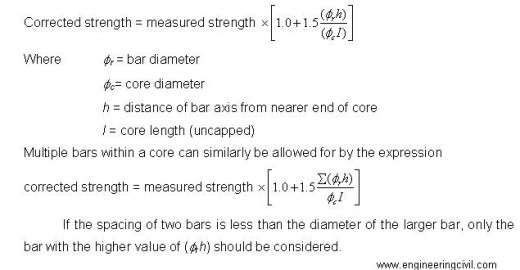
Table-1 : Proforma for core test
Core Strength Correction factor
| L/D Ratio | ASTM: C-42 | IS: 516 |
| 2.00 | – | 1.00 |
| 1.75 | 0.98 | 0.97 |
| 1.50 | 0.96 | 0.95 |
| 1.25 | 0.93 | 0.92 |
| 1.00 | 0.87 | 0.89 |
- Nominal maximum size of aggregate =
- Type and grade of cement =
- Grade of concrete =
- Date of casting of structure member =
- Date of core drilling =
- Date of core testing =
| S.No. | Id of core | Location | Core dia (mm) | Core length after grinding (mm) | Core length after capping (mm) | Weight (kg) | Density (kg/m3) | L/D Ratio |
| a | b | c | d | e | f | g | h | I |
| 1. |
|
|
|
|
|
|
|
|
| 2. |
|
|
|
|
|
|
|
|
| 3. |
|
|
|
|
|
|
|
|
| S.No. | Core area (mm2) | Ultimate Load (kN) | Core strength (N/mm2) | Correction factor | Corrected core strength (N/mm2)l´m | Equ. Cube strength (N/mm2) n´1.25 | Rebar corrected cube strength (N/mm2) | Remarks |
| j | K | L | m | n | o | p | q |
| 1. |
|
|
|
|
|
|
|
|
| 2. |
|
|
|
|
|
|
|
|
| 3. |
|
|
|
|
|
|
|
|
REFERENCES
- IS: 456-2000, Plain and reinforced concrete – Code of Practice (Fourth Revision) BIS, New Delhi.
- IS: 516-1959, Method of test for strength of concrete, BIS, New Delhi.
- IS: 1199-1959, Method of sampling and analysis of concrete.
- ASTM: C42/C42 M-04, Standard test method for obtaining and testing drilled cores and sawed beams of concrete.
- BS 1881: Part 120:1983, Method for determination of the compressive strength of concrete cores.
- Concrete core testing for strength, Tech. Report 11, Concrete Society, London, 1987.
- H. Bungey, S.G.Millard, M.G. Granthan, Testing of concrete in structures Fourth Edition.
- V. Nayak, A.K. Jain, Advanced Concrete Technology.












